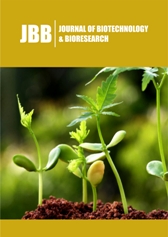- Submissions

Full Text
Journal of Biotechnology & Bioresearch
How Can we Help Tropical Trees to Acclimate to Global Warming?
Malavasi UC*
Forest Engineer, Professor PhD in Forest Sciences-Center of Agricultural Sciences-State University of Western Paraná/Unioeste-Rua Pernambuco 1777- 85960-000- Marechal Candido Rondon, PR, Brazil
*Corresponding author:Malavasi UC, Forest Engineer, Professor PhD in Forest Sciences-Center of Agricultural Sciences – State University of Western Paraná/ Unioeste- Rua Pernambuco 1777- 85960- 000- Marechal Candido Rondon, PR, Brazil
Submission: September 15, 2025;Published: September 23, 2025

Volume5 Issue 5September 23, 2025
Opinion
It has been argued that the best hope for Tropical Tree Species (TTS) to avoid extinction is individual-level acclimation [1]. Adequate management strategies to improve tolerance to water deficit are necessary to mitigate drought upon planting of tree seedlings. Seedling hardening is to induce a controlled stress which may foster survival and reduce replanting. TTS use a variety of strategies to cope with environment stresses depending on the species and on the plant developmental stage. Increased or accelerated senescence and leaf abscission are common TTS responses to stresses. Moreover, TTS are reported not only to avoid stresses by growing larger and deeper root systems but also implementing different source-sink transitions by allocating biomass and nutrients to vegetative growth. Abiotic stresses such as drought, which can be exacerbated by other factors such as salinity and extreme temperatures, pose important constraints to tropical tree species productivity throughout various biomes. Drought is an important abiotic stress that affects cell membrane integrity, osmotic adjustment, and photosynthetic ability posing a major limitation to tree growth and development. Under severe drought stress, seedlings may experience severe hydraulic failure or even diebacks. Small seedlings are considered less efficient in terms of water uptake and more sensitive to water deficit than larger seedlings. Recent studies have reported the importance of recording simultaneous plant responses, which are able to capture plant plastic adjustments to stress [2,3]. Regarding seedling drought hardening, it is possible to find description of experimental methods Marchin RM [4] for inducing such stress by withholding or reducing water availability and lowering substrate/soil water content (water potential). Duration and intensity of the induced drought stress accounts for much of the differences among studies. An alternative hardening practice to drought hardening is to reduce leaf area which in turn reduces the evaporative area while maintaining an intact and efficient root system to maintain a favorable water status. Manuscripts reporting drought hardening experimental practices on seedlings of TTS include ethephon on Cariniana estrellensis, shading on Calophyllum brasiliensis, Aegiphila integrifolia, Guazuma ulmifolia and Heliocarpus popayanensis, water management on Handroanthus impetiginosus and on Euterpe edulis, methyl jasmonate on Cordia trichotoma, stem bending on Maytenus ilicifolia, Inga sessilis and Nectandra grandiflora, jasmonic acid on Handroanthus impetiginosus and Patagonula americana, ethylene on Pachystroma longifolium, light management on Guazuma ulmifolia, and salicylic acid on Schinus terebinthifolius Raddi. Global warming projections introduce large uncertainties about the sustainability of current seedling propagation practices involving tropical tree species. Therefore, nursery management should target to use of preconditioning practices to induce plant mechanisms for drought resistance and/or growth regulators to control seedling biomass distribution which are strategic to achieve planting success of future plantation and revegetation projects.
References
- Feeley KJ, Bernal-Escobar M, Fortier R, Kullberg AT (2023) Tropical trees will need to acclimate to rising temperatures-but can they? Plants 12(17): 3142.
- Laughlin DC, Messier J (2015) Fitness of multidimensional phenotypes in dynamic adaptative landscapes. Trends Ecol Evol 30(8): 487-496.
- Shipley B (2016) Reinforcing loose foundation stones in trait-based plant ecology. Oecologia 180(4): 923-931.
- Marchin RM (2020) A simple method for simulating drought effects on plants. Front Plant Sci 10: 1715.
© 2025 Malavasi UC*. This is an open access article distributed under the terms of the Creative Commons Attribution License , which permits unrestricted use, distribution, and build upon your work non-commercially.
 a Creative Commons Attribution 4.0 International License. Based on a work at www.crimsonpublishers.com.
Best viewed in
a Creative Commons Attribution 4.0 International License. Based on a work at www.crimsonpublishers.com.
Best viewed in 







.jpg)






























 Editorial Board Registrations
Editorial Board Registrations Submit your Article
Submit your Article Refer a Friend
Refer a Friend Advertise With Us
Advertise With Us
.jpg)






.jpg)














.bmp)
.jpg)
.png)
.jpg)










.jpg)






.png)

.png)



.png)






